
|
It brightened rapidly in early June, and reached to 8.9 mag on June 10 (Juan Jose Gonzalez). Nucleus split was found on June 12 by many persons including Giovanni Sostero. Then it keeps 9 mag, and 9.2 mag now (June 17, Juan Jose Gonzalez). Not observable already in the Northern Hemisphere. In the Southern Hemisphere, it is observable until early July in the evening low sky. It will be unobservable in mid July. However, it will appear again in the morning at 12 mag in late July, then it will be higher. But it will fade out rapidly. In September when it will become observable again in the Northern Hemisphere, it will be 14-16 mag. At the perihelion passage on July 5, t will approach to the sun down to 0.54 AU. Because the absolute magnitude is faint as 13-14 mag, it can decline and become much fainter than expected after that.
Date(TT) R.A. (2000) Decl. Delta r Elong. m1 Best Time(A, h)
June 25 8 43.75 16 3.4 0.764 0.595 35 9.0 21:04 (107, 1)
July 2 8 33.34 3 53.4 0.909 0.550 32 9.0 21:04 (103,-13)
|
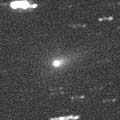
|
Although it was faint as 15.2 mag on Mar. 14 (Yuji Ohshima), it brightened in April, and finally it became bright enough to be visible visually, 12.3 mag on May 2 (Juan Jose Gonzalez). The comet keeps brightening, and now it is bright as 9.6 mag (June 16, Juan Jose Gonzalez). It keeps slightly fainter than this ephemeris. It keeps 10 mag until July. However, it keeps locating very low in the morning. The altitude keeps lower than 20 deg until September when it becomes fainter than 12 mag. It will be higher than 30 deg after October, when it will be already fainter than 13 mag.
Date(TT) R.A. (2000) Decl. Delta r Elong. m1 Best Time(A, h)
June 25 2 49.30 23 1.0 1.425 1.044 47 10.1 3:00 (254, 18)
July 2 3 21.78 21 48.1 1.429 1.038 46 10.2 3:04 (255, 17)
|
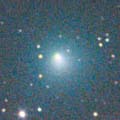
|
It was not visible visually still in February, fainter than 13.9 mag (Feb. 5, Seiichi Yoshida). However, it brightened very rapidly after that as expected, and reached to 10.6 mag at the end of April (Apr. 30, Shigeki Murakami). Then it keeps bright at 10 mag. Now it is 10.1 mag (June 6, Seiichi Yoshida). But, this is fainter than originally expected by 0.5 mag. Getting diffused gradually. It will keep 10 mag until the end of July in calculation. But it may become a naked-eye object due to the Deep Impact mission on July 4. Actually, this is the first experience in our history, and it is very uncertain what will happen on this comet. Observations are strongly encouraged.
Date(TT) R.A. (2000) Decl. Delta r Elong. m1 Best Time(A, h)
June 25 13 22.40 -5 54.3 0.849 1.510 107 10.1 21:04 ( 40, 41)
July 2 13 33.85 -8 40.5 0.883 1.507 104 10.2 21:04 ( 42, 36)
|

|
It was fantastic, so bright as 3.5 mag, so large as 30 arcmin, locating high overhead at its best time in early January. Then it has been getting fainter and smaller gradually, and 9.8 mag now (June 6, Seiichi Yoshida). The diameter is about 6 arcmin now. It became faint and small, however, it is still easy to see with a telescope. In the Northern Hemisphere, it keeps observable in good condition for a long time while the comet is bright enough visible visually until October when it becomes faint as 14 mag. Dennis Persyk detected the 27-arcmin long anti tail in late May. The long anti tail has been visible until now. Because earth passed across the orbital plane of the comet in late June, the tail will be detected for a while after this.
Date(TT) R.A. (2000) Decl. Delta r Elong. m1 Best Time(A, h)
June 25 13 9.12 35 1.6 2.313 2.477 86 10.8 21:04 ( 99, 63)
July 2 13 16.51 32 17.9 2.447 2.554 84 11.0 21:04 ( 95, 59)
|
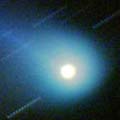
|
The brightness evolution had been slower than a typical comet since its discovery until the perihelion passage in early April. Although it kept bright as 8 mag from mid March to early May, it seems to start fading in mid May as expected, 8.4 mag on May 12 (Michael Mattiazzo). After this, it is not observable in the Northern Hemisphere until late September when it appears very low sky at dawn as 14 mag. It keeps lower than 20 deg high until early July even in the Southern Hemisphere. The comet will fade out rapidly after this, down to 12 mag until early July. However, no observations have been reported since mid May, so it is uncertain how the comet is fading now. Unusually strong non-gravitational parameters are revealed by the orbital calculation, but the reason has not been revealed yet.
Date(TT) R.A. (2000) Decl. Delta r Elong. m1 Best Time(A, h)
June 25 5 55.48 -34 47.6 1.941 1.653 58 11.0 3:00 (285,-50)
July 2 6 11.76 -34 9.1 2.062 1.745 57 11.3 3:04 (285,-47)
|
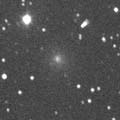
|
It was 14 mag on May 12 when appearing in the morning low sky (Michael Mattiazzo). Then it has been brightening as expected, and now it is 11.3 mag (June 16, Juan Jose Gonzalez). But the current brightness is fainter than the previous appearance by 1 mag. In the Northern Hemisphere, it keeps observable for a long time after this, and is expected to reach to 9 mag from July to August. However, it unexpectedly brightened after the perihelion passage in its last appearance, and reached to the maximum brightness about 45 days after the perihelion passage. If it was due to the outburst, it may reach only to 11.5 mag at best in this return. In the Southern Hemisphere, it is not observable until it becomes faint.
Date(TT) R.A. (2000) Decl. Delta r Elong. m1 Best Time(A, h)
June 25 2 8.19 55 27.0 1.550 1.276 55 11.4 3:00 (223, 37)
July 2 2 33.10 64 2.1 1.501 1.285 57 11.2 3:04 (213, 39)
|

|
In January when it was visible in the Northern Hemisphere, it was an 11 mag small object. However, after it has gone to the southern sky, it reached to 8.0 mag, bright enough to be visible with binoculars, from March to April (Mar. 4 and Apr. 7, Alexandre Amorim). It must have started fading after mid April, however, it kept bright as 8.9 mag still on May 12 (Michael Mattiazzo), brighter than expected by 1 mag. Then, it had been very low even in the Southern Hemisphere, while it had been fading as 10-10.5 mag on May 31 and about 11 mag on June 15 (Terry Lovejoy). It brightened rapidly before the perihelion passage, but it is fading in moderate speed after the perihelion passage. It is appearing in the morning sky after the long blank also in the Northern Hesmisphere. It keeps observable in good condition until winter when it becomes fainter than 18 mag.
Date(TT) R.A. (2000) Decl. Delta r Elong. m1 Best Time(A, h)
June 25 1 59.22 5 40.6 1.729 1.573 63 11.3 3:00 (276, 18)
July 2 1 56.65 8 32.8 1.707 1.662 70 11.5 3:04 (279, 27)
|

|
Although it was only 19 mag in January, it has been brightening rapidly as expected since that, and it reached to 13.4 mag on May 20 (Mitsunori Tsumura). It finally became visible visually at 12.5 mag on June 7 (John Drummond). It is expected to keep visible as bright as 12-13 mag for a long time until September. In the previous return, it was 1.5 mag brighter than this ephemeris visually. So it can be around 11.0 mag visually at best in this return, too. The condition is good in the Southern Hemisphere. However, it keeps locating very low in the Northern Hemisphere. It is September when it becomes higher than 30 deg.
Date(TT) R.A. (2000) Decl. Delta r Elong. m1 Best Time(A, h)
June 25 15 46.56 -37 51.6 0.675 1.618 145 12.3 21:32 ( 0, 17)
July 2 15 50.18 -36 38.5 0.683 1.603 140 12.3 21:08 ( 0, 18)
|
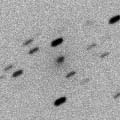
|
New periodic comet with a very short period of 4.4 years. Now it is passing very close by the earth, about 0.1 AU. Although it was so faint as 17.5 mag in early May, it brightened rapidly and reached to 13.5 mag on June 6 (Michael Jager). It has a very large and faint coma with a diameter of 5-6 arcmin. However, it was not visible visually, fainter than 13.7 mag (June 6, Seiichi Yoshida). Because it is very large and diffused, it will be hard to see it without clear sky. Surprisingly, it was detected on survey images on June 24 as a very bright and large object, 8-9 mag with a diameter of 20 arcmin (Terry Lovejoy). However, Michael Jager observed it on the same day and reported it as 11.5-12.0 mag. Anyway, it will be unobservable soon, too close to the Sun. It will appear in the morning again in late July at 15 mag, then it keeps observable while fading gradually.
Date(TT) R.A. (2000) Decl. Delta r Elong. m1 Best Time(A, h)
June 25 10 36.35 16 29.7 0.105 0.970 61 12.5 21:04 ( 95, 23)
July 2 8 32.27 17 41.8 0.109 0.920 25 12.3 21:04 (116, -6)
|

|
It was bright as 7.5 mag in early January, easy to see with binoculars. However, it faded and got diffused rapidly in the evening sky after that. It faded to 10.7 mag on Mar. 15 visually (Alexandre Amorim), and 11.5 mag on Apr. 4 by CCD observation (Mitsunori Tsumura), then it became unobservable. It has been already appearing at dawn since mid June in the Southern Hemisphere, but no observations have been reported. In the Northern Hemisphere, it will appear in the morning sky in August. It may be still brighter than 14 mag at that time and visible visually.
Date(TT) R.A. (2000) Decl. Delta r Elong. m1 Best Time(A, h)
June 25 4 23.68 -3 52.0 4.405 3.664 38 13.3 3:00 (263,-17)
July 2 4 26.25 -3 53.3 4.417 3.739 43 13.4 3:04 (267,-11)
|

|
It will reach to 9 mag in 2006 spring. In the Southern Hemisphere, it keeps observable until that. In the Northern Hemisphere, it is not observable until 2006 March, except it appears very low in the morning at 12 mag from late August to early September. After 2006 March, northern people can observe it for a long time while it is getting fainter. It had been brightening well as expected until 2005 March. It was 15.1 mag on Mar. 5 (Mitsunori Tsumura). However, no observations have been reported since mid March, so the current brightness is uncertain. Although it has been extremely low even in the Southern Hemisphere for a while, it will locate high again after July.
Date(TT) R.A. (2000) Decl. Delta r Elong. m1 Best Time(A, h)
June 25 4 59.99 -17 13.7 3.907 3.262 44 13.6 3:00 (270,-32)
July 2 5 5.73 -18 10.8 3.788 3.194 47 13.4 3:04 (274,-27)
|

|
It was 16.4 mag at the discovery in March (Mar. 12, R. H. McNaught), but it brightened up to 14.4 mag on June 6 (Yuji Ohshima). It is expected to be bright as 10 mag in early 2006. In the Southern Hemisphere, it keeps locating high until November while the comet is getting brighter gradually. In the Northern Hemisphere, it keeps locating very low around 15 deg high until September. So, it may be too hard to see visually for a long time.
Date(TT) R.A. (2000) Decl. Delta r Elong. m1 Best Time(A, h)
June 25 20 32.99 -38 42.4 2.518 3.415 147 13.7 2:21 ( 0, 16)
July 2 20 28.67 -39 8.9 2.411 3.347 152 13.6 1:49 ( 0, 16)
|

|
Appearing at dawn. It was 14.2 mag on May 31 (Ken-ichi Kadota). Now it is not so bright, but not so faint., It had been always brighter than 13 mag and visible visually all through the season in 2004. In 2005, it is observable in very good condition, almost overhead in the Northern Hemisphere from summer to winter. It can be a good target of observaions if it becomes active as in 2004.
Date(TT) R.A. (2000) Decl. Delta r Elong. m1 Best Time(A, h)
June 25 2 2.05 21 18.9 6.220 5.747 58 13.7 3:00 (261, 26)
July 2 2 5.91 21 48.2 6.127 5.748 63 13.6 3:04 (264, 32)
|

|
It had been lost for a long time. It was recovered in 1978. However, it was missed in two returns after that, and now it is lost again. Probably it is extremely faint normally, and it was observed only when it rarely brightened. It seems to locate around the predicted position, but it must be much fainter than this ephemeris. The condition in this return is bad. It keeps locating extremely low, so it will be impossible to recover. In the Southern Hemisphere, it locates over the horizon, but very low.
Date(TT) R.A. (2000) Decl. Delta r Elong. m1 Best Time(A, h)
June 25 4 5.65 19 43.3 1.494 0.802 30 14.0 3:00 (247, 1)
July 2 4 41.22 22 10.1 1.562 0.824 28 14.4 3:04 (244, 2)
|

|
It kept 12.5-13.0 mag since November, and it was visible visually as 12.7 mag still on May 4 (Seiichi Yoshida). Then the altitude has been getting lower and lower. It will be unobservable in this return soon.
Date(TT) R.A. (2000) Decl. Delta r Elong. m1 Best Time(A, h)
June 25 8 55.50 27 9.2 2.727 2.000 36 14.3 21:04 (116, 11)
July 2 9 13.42 25 52.3 2.789 2.027 33 14.4 21:04 (116, 9)
|

|
It has already appeared in the morning low sky in the Southern Hemisphere. It was 13.6 mag on May 12, as bright as expected (Michael Mattiazzo). It is appearing at dawn also in the Northern Hemisphere. It will be fading after this.
Date(TT) R.A. (2000) Decl. Delta r Elong. m1 Best Time(A, h)
June 25 3 20.81 8 57.6 2.520 1.924 44 14.3 3:00 (262, 4)
July 2 3 34.74 9 36.8 2.511 1.967 47 14.5 3:04 (263, 7)
|
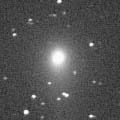
|
Although it had been rather large, well condensed, and easy to see until February, it became diffused in March. However, it keeps bright visually still now, 12.8 mag on May 4 (Seiichi Yoshida). The fading after the perihelion passage is slow, and it will keep visible at 14 mag for a while after this. However, no visual observations have been reported since mid May. In the Northern Hemisphere, it is getting lower slowly in the evening sky, but it will be higher than 20 deg still in mid August.
Date(TT) R.A. (2000) Decl. Delta r Elong. m1 Best Time(A, h)
June 25 9 23.96 61 2.2 3.634 3.073 49 14.8 21:04 (146, 31)
July 2 9 43.38 59 12.0 3.718 3.129 47 14.9 21:04 (144, 29)
|

|
New bright periodic comet discovered in 2004 spring. It had been bright at 15.0-15.5 mag from spring to summer in 2004. The ephemeris says it keeps brighter than 19 mag even around the aphelion, however, the comet had not been discovered before 2004. This suggested the comet became bright temporarily last year. But actually, it keeps the same brightness in 2005, too. Now it is 14.8 mag (May 15, Akimasa Nakamura). It will be bright at 14.5 mag until autumn. However, it locates very low, around 20 deg high, in the Northern Hemisphere. So it will be hard to see it visually.
Date(TT) R.A. (2000) Decl. Delta r Elong. m1 Best Time(A, h)
June 25 20 28.12 -32 26.9 2.089 3.008 149 14.9 2:16 ( 0, 23)
July 2 20 24.45 -33 21.9 2.064 3.020 155 14.9 1:45 ( 0, 22)
|
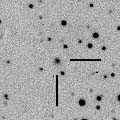
|
It brightened from 18 to 15 mag during one year from the end of 2003 to early 2005. The brightness evolution was much faster than that of a typical comet. After that, it kept 15-15.5 mag until May. Although it is not observable for a while, it will be getting higher again in August. It can be 13 mag and may be visible visually in next winter.
Date(TT) R.A. (2000) Decl. Delta r Elong. m1 Best Time(A, h)
June 25 7 7.03 45 36.1 6.537 5.629 24 14.9 21:04 (144, 6)
July 2 7 16.21 45 30.4 6.527 5.609 23 14.9 21:04 (146, 3)
|
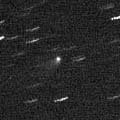
|
It was faint as 16.5 mag in early February. Then it has been brightening as expected, and reached to 15.2 mag in late April (Apr. 27, Ken-ichi Kadota). It will be observable in good condition at 14.5-15 mag until mid July. Because it locates high, it will be visible visually with a large telescope when the sky is clear. It was observed visually at 15.0 mag on May 7 (Shigeki Murakami). It brightened furthermore by 1 mag, 14.1 mag on June 13 by CCD observation (Yusuke Ezaki).
Date(TT) R.A. (2000) Decl. Delta r Elong. m1 Best Time(A, h)
June 25 14 50.64 17 9.5 2.834 3.401 115 15.1 21:04 ( 22, 71)
July 2 14 37.68 16 44.9 2.948 3.399 107 15.2 21:04 ( 45, 66)
|
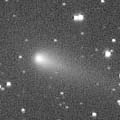
|
Although it had been strongly condensed until early January, it became diffused since late January. It had been fading gradually, around 11.5 mag in January and around 12.5 mag in February. It was still bright at 12.6 mag on Mar. 8 (Seiichi Yoshida). Although the brightness evolution before the perihelion passage was extremely rapid, the fading after the perihelion passage was slow as expected. It is already unobservable in this return.
Date(TT) R.A. (2000) Decl. Delta r Elong. m1 Best Time(A, h)
June 25 7 48.06 16 21.6 3.639 2.731 22 15.1 21:04 (117, -8)
July 2 8 0.17 15 49.9 3.702 2.763 19 15.3 21:04 (118,-11)
|

|
It brightened rapidly from 19 to 17 mag in early 2004. But it is in normal state now, brightening gradually. It keeps 15-16 mag for a long time until early 2007. Although it does not locate very high in the Northern Hemisphere, it is also visible visually. Visual brightness is 14.3 mag on May 7 (Juan Jose Gonzalez) and 14.2 mag on June 7 (John Drummond), very small with a diameter of 0.2-0.6 arcmin.
Date(TT) R.A. (2000) Decl. Delta r Elong. m1 Best Time(A, h)
June 25 15 22.88 -19 56.7 2.314 3.161 139 15.1 21:08 ( 0, 35)
July 2 15 20.99 -20 4.3 2.370 3.152 132 15.2 21:04 ( 7, 35)
|

|
Recovery of a peculiar asteroid 2004 FS101 discovered in 2004 spring. Although it was 18 mag in mid January, it brightened to 16-16.5 mag in mid May. The brightness evolution was rather faster than that of a typical comet. It will be 14.5 mag around 2006 January, although it will be rather low for the northern observers. It keeps observable at 15-16 mag for a long time from 2005 spring to the end of 2006. Because it moves in the northern sky, it keeps observable for a long time in the Northern Hemisphere.
Date(TT) R.A. (2000) Decl. Delta r Elong. m1 Best Time(A, h)
June 25 13 10.77 49 54.0 3.977 3.942 80 16.0 21:04 (132, 62)
July 2 13 9.65 49 42.5 4.015 3.906 76 16.0 21:04 (129, 58)
|

|
Moving northwards, so it will locate high in the Northern Hemisphere after this. It will be observable in good condition at 15.5 mag from July to November. Maybe it will be visible visually.
Date(TT) R.A. (2000) Decl. Delta r Elong. m1 Best Time(A, h)
June 25 1 6.06 2 16.4 1.498 1.617 77 16.2 3:00 (288, 27)
July 2 1 22.86 5 12.1 1.437 1.595 79 16.0 3:04 (288, 32)
|

|
Peculiar asteroid moving along the orbit like a short periodic comet. It passed close by the earth from May to June, and reached to 14 mag. Now it is fading very quickly. It will be fainter than 18 mag in mid July. It was so faint as 18.5 mag in early April when it passed the perihelion, which suggests this object is indeed an asteroid. Michael Mattiazzo reported that it was completely stellar on May 29. It was not visible, fainter than 14.0 mag on June 6 (Seiichi Yoshida).
Date(TT) R.A. (2000) Decl. Delta r Elong. m1 Best Time(A, h)
June 25 15 44.20 4 2.8 0.607 1.504 134 16.6 21:29 ( 0, 59)
July 2 15 44.34 8 26.0 0.729 1.561 125 17.1 21:04 ( 1, 64)
|

|
It will be 16.5 mag both in 2005 summer and 2006 summer. It moves southwards, so the condition in the Northern Hemisphere is better in 2005.
Date(TT) R.A. (2000) Decl. Delta r Elong. m1 Best Time(A, h)
June 25 16 54.62 60 56.6 3.732 3.937 94 16.8 22:38 (180, 64)
July 2 16 46.37 59 18.0 3.710 3.917 94 16.8 22:03 (180, 66)
|

|
It will be 15.5 mag from September to December. Not observed yet in this return. However, it is already high in the morning sky, and it must be brightening rapidly now.
Date(TT) R.A. (2000) Decl. Delta r Elong. m1 Best Time(A, h)
June 25 23 59.32 -2 53.5 2.535 2.809 94 17.4 3:00 (305, 36)
July 2 0 5.99 -2 26.3 2.420 2.779 99 17.2 3:04 (311, 40)
|
|
![]()
 C/2005 E2 ( McNaught )
C/2005 E2 ( McNaught ) 29P/Schwassmann-Wachmann 1
29P/Schwassmann-Wachmann 1 72P/Denning-Fujikawa
72P/Denning-Fujikawa 32P/Comas Sola
32P/Comas Sola 10P/Tempel 2
10P/Tempel 2 C/2004 Q1 ( Tucker )
C/2004 Q1 ( Tucker ) P/2004 F3 ( NEAT )
P/2004 F3 ( NEAT ) C/2003 WT42 ( LINEAR )
C/2003 WT42 ( LINEAR ) C/2004 K1 ( Catalina )
C/2004 K1 ( Catalina ) 78P/Gehrels 2
78P/Gehrels 2 117P/Helin-Roman-Alu 1
117P/Helin-Roman-Alu 1 C/2005 B1 ( Christensen )
C/2005 B1 ( Christensen ) P/2005 K3 ( McNaught )
P/2005 K3 ( McNaught ) 2004 YZ23
2004 YZ23 C/2005 K1 ( Skiff )
C/2005 K1 ( Skiff ) 101P/Chernykh
101P/Chernykh![]()



















